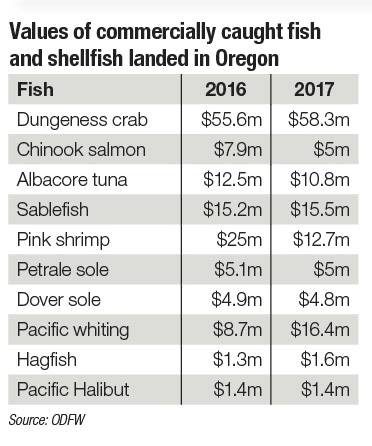Drought and poor ocean conditions wipe out stocks of the popular fish.
The sad story of an orca carrying her dead calf for 17 days off the Washington coast this month has garnered global attention to the plight of killer whales in the region. It has also highlighted the steep decline in the region’s salmon stocks, the resident orcas’ sole food source.
Malnutrition is thought to have led to declining fertility and low survival rates in juveniles in the pod to which the orca belongs. That is because the availability of Pacific Ocean salmon has been trending low for the past decade.
The total pounds of chinook salmon caught off the Oregon coast in 2017 fell 40% compared with the year before, according to Oregon Department Fish & Wildlife (ODFW) data. Between 2014 and 2017, total pounds caught dropped 80% and the value of the catch dropped 72% to $5 million.
Drought in California and nutrient-starved ocean conditions are blamed for the decline.
“In 2017 we had a big chunk of the Oregon coast closed to salmon fishing,” says Eric Schindler, ocean sampling project leader for ODFW. “When smolt hit the ocean, they did not have a good survival rate.”
Low water levels in the Klamath River and Rogue River basins in southern Oregon and northern California have also contributed to the decline in chinook salmon.
The amount of Pacific coastal salmon has been trending low since 2006, says Schindler. “It is possible it will be the norm as we move forward,” he says.

The exception to the downward trend was in 2014 when 4.8 million pounds of chinook salmon was caught off the Oregon coast at a value of $18.3 million. “It was a good harvest, especially as the fishing fleet was not as large,” he says.
It is too early to tell whether the salmon harvest this year will be below last year. The number of salmon caught off the Oregon coast from April through July was around 14,000, compared with around 18,000 in the same period last year. But fishing has picked up in August because of increased currents that have created nutrient-rich water for the salmon, says Schindler.
“We have a lot of good conditions this year. Chinook will probably have good survival,” he says.
While experts point the finger at climate-related reasons for the salmon decline, hydroelectric dams are also blamed for damaging fish habitat. Opinions are mixed on how much they have contributed to the downward trend.
The Pacific Coast Federation of Fishermen’s Associations, a trade group of commercial fishermen on the West Coast, supports the removal of dams, which block the natural migration of salmon.
Glen Spain, Northwest regional director, said his association advocated for the removal of the Klamath River dams, which is slated to be the U.S.’s largest dam removal project to date. The Klamath River basin is an important spawning ground for chinook salmon.
In June, the Klamath River Renewal Corporation, a non-profit that plans to take ownership of the dams, submitted a proposal to the Federal Energy Regulatory Commission to remove the four PacificCorp.-owned dams in Oregon and California. Spain said the dams’ removal is estimated to double the annual salmon runs in that region.
“It will greatly enhance the ability of salmon to thrive in what was historically important salmon runs,” said Spain.
Schindler at ODFW is more hesitant to predict larger salmon harvests resulting from the removal of the dams.
“The dams caused a lot of problems in the Klamath River, but in days when river conditions were good, the hatcheries had good productivity. The question will be whether natural productivity be restored to the system that will exceed what is coming out of the hatchery,” says Schindler.
Salmon is not the only fish on the decline. Harvests of pink shrimp and albacore tuna were down on last year. But this has not greatly impacted Oregon’s commercial fishing sector revenues, which have been stable for the past decade.
Last year, harvests of all fish types was $144 million, according to Oregon Employment Department research. Landings have averaged $147 million a year since 2010.

The declines in salmon, pink shrimp and tuna were offset by gains in other fish, namely dungeness crab, groundfish and whiting, a relative of cod. Dungeness crab is usually Oregon’s most valuable fishery.
We might be seeing more of the less common fish on the dinner plate if the more popular fish stocks continue to fall.





